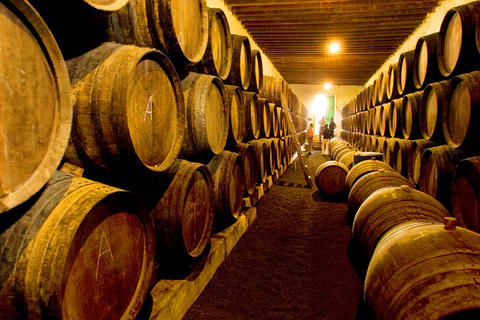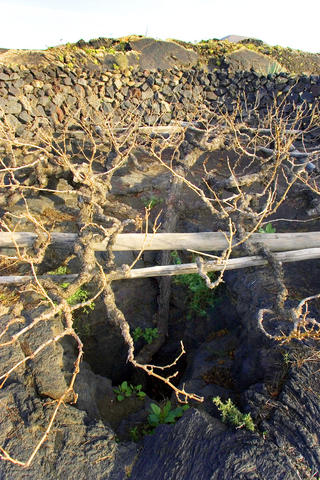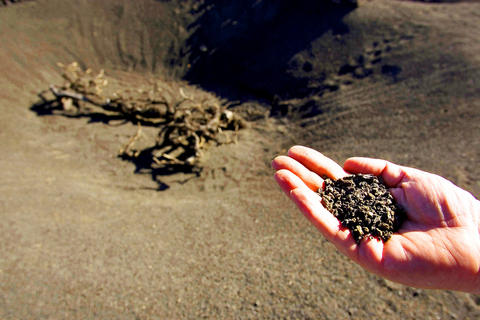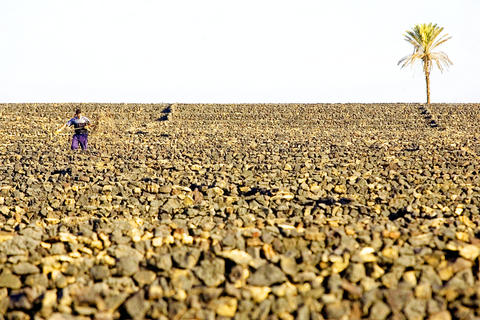If God had a cat and one day accidentally hoofed over its litter tray, his clumsiness could explain the creation of Lanzarote. Volcanoes have spilt an extraordinary charcoal-black gravel across great swaths of the island, painting its landscape from a palette not quite of this planet.
Cat litter is not usually something you would fly for hours to scrunch around in, but it is for an entirely different reason that for years Lanzarote has been twinned with a word beginning in "gr" and ending in "otty." This old cliche ignores the ancient vineyards, caves and the pretty white houses that sparkle against this Canary Island's black beauty. It sees only the package holiday industry, which herds tourists in and out of this fantasy island where the sun shines all year and the booze and smokes are come-again cheap.
In Britain, at least, we tend to ignorantly assume that this small island only 130km from the African coast has been as drastically shaped by mass tourism as by the volcanoes that erupted over the island in the 18th and early 19th centuries. We are completely wrong.

PHOTO: NY TIMES NEWS SERVICE
One local man has done far more to create modern Lanzarote than millions of British tourists. Cesar Manrique was born on the island in 1919 and raised on its untouched beaches. An acclaimed modern artist, and later architect, Manrique mixed with the likes of Picasso and Andy Warhol in Spain and New York before returning home to great acclaim in the late 1960s.
Preserved retreat
Just as package tourism was taking off, Manrique devoted himself to a prescient passion for genuinely sustainable development. He died in a car accident in 1992, but many islanders fight on to preserve his legacy. Thanks to Manrique's influence, there are no roadside advertising hoardings in Lanzarote, just one high-rise building on the entire island and the attractive historic towns, such as Haria in the north and Yaiza in the south, remain painted in their traditional colors - white walls and dark green doors and window frames.

PHOTO: NY TIMES NEWS SERVICE
As soon as I drove 15 minutes from the airport into the island's volcanic wine-growing region it was obvious that mass tourism has been almost completely contained in the low-rise resorts such as Puerto del Carmen and Playa Blanca on the island's south coast. Both are fairly sleepily inoffensive, and if you are really against Brit-Irish bars you can easily steer clear of them; the only time I saw package tourists was when their pink faces were pressed against the window of their tour bus as it sweated through Famara village where I was tucking into some post-surf lunch.
At the bottom of a dusty black track is an oasis of cacti, palms and pink bougainvillea set around a pool built in the style of Manrique. The four boutique apartments of Finca Malvasia, set in an old working vineyard, have been transformed by a young British couple, Tarnya and Richard Norse-Evans, who fell in love with the island and its surf a decade ago and finally permanently relocated there earlier this year.
They offer a nicely personal take on chic self-catering apartments, which they have refitted with appropriately mid-century modernist furnishings. Guests can order platters of local produce for breakfast, get surf lessons or guided trips with Richard or indulge in spa, massage and yoga treatments in a pleasing round stone hut on the edge of the vineyard.

PHOTO: NY TIMES NEWS SERVICE
The couple are also a mine of useful information about everything from the best secret surf spots to local wines, and on the first evening served up a very decent bottle of white made from the grapes from their own vineyard.
The sun reliably shone on the first day and the surf was up. With its wind and waves, Lanzarote is a natural home for extreme sports, with serious winter waves beginning this month.
Cyclists tilt up the twisting mountain roads and experienced European triathletes undertake warm-weather training during winter. Amateurs can try almost anything that requires a board and a bit of daring. My daring quotient is less than most so Richard lent me a lurid pink bodyboard.

PHOTOS: NY TIMES NEWS SERVICE
On the northwest side of the island, the Atlantic Ocean crashes onto a 6km curve of sand at Famara the color of coffee cake. Here is where the surfers gather - mostly local and Spanish, but also a few Australians and the odd Brit.
While the Canarians will sometimes protect their secret surf spots by shouting at tourist surfers who are more dud than dude, Famara regulars tolerated my inept wave-riding on the pink board (although I was too busy wiping out to notice their disdain).
The swimming and snorkeling around the intimate coves of Papagayo on the south of the island were more my style, but during the drive there it became obvious that Lanzarote need not just be a beach holiday.

PHOTOS: NY TIMES NEWS SERVICE
For a small island of spectacular emptiness, there is a surprising amount to see, mostly thanks to Manrique. If his strictures about conserving Lanzarote's traditions sound austere, his architecture was organic and sensual.
His first work on the island was the Jameos del Agua, a subterranean garden, restaurant, pool and concert hall, built into a network of volcanic caves. Blind albino crabs scuttle in the waters of this lava grotto.
The house that Manrique built for himself is also a major attraction and now exhibits his modern art collection. Its design, typically, mixes traditional architecture and the island's natural rock formations, setting rooms in a series of volcanic bubbles formed during the 18th-century eruptions. You stumble across his influence and his work everywhere, from the cactus garden he designed to the island's roundabouts, many of which are decorated with his sculptures.
Omar Sharif's stopmping grounds
I didn't realize until afterwards, but Manrique also entertained me at night. After a meal in Teguise, the historic, pretty former capital of the island, I drove to the top of the hill at nearby Nazaret. Behind a deserted and not terribly well-regarded restaurant were gardens, a natural cliff and a cave, from which cascaded the thud and warble of Moloko and Shakira.
The bar at LagOmar (also known as La Cueva - the Cave) is probably the weirdest in the world. Enter it and you are transported straight to the island of 1970s James Bond baddie Francisco Scaramanga. One barman looked slightly alarming with one bright blue eye and one brown eye; the other, a man with a piratical beard and white neckerchief maniacally assembling caipirinhas all night, was terrifying.
Then there was the anxious and apparently resident Alsatian dog trying to scramble up the back wall of the cave, surrounded by an appropriate blend of playboys, Eurotrash and local students. Like most Canarians, they tend only to get going after midnight when, on this particularly Friday at least, the rather less than crowd-pleasing, middle-aged DJs finally stopped rearranging their CD collection and began playing what could politely be called an eclectic mix of dated French house and chart R 'n' B.
It all made sense the next morning when I discovered that the bar was designed by Manrique as part of a bachelor pad for Omar Sharif. Legend has it the actor lost it in a card game.
For all the revisionism about the newly chic Canaries, however, you wouldn't come to Lanzarote for the nightlife. The unprepossessing capital, Arrecife, has a reasonable number of bars and clubs but it's all chart-toppers and teenagers. A better way to spend an evening is tasting fresh fish at the small, sweet strip of restaurants at El Golfo, where there is a lagoon of emerald water - another exotic natural feature courtesy of those overactive volcanoes.
My favorite meal out was at El Charcon, a simple waterside restaurant in the fishing village of Arrieta that served up excellent papas arrugadas y mojo, local salted potatoes with the fantastic, ubiquitous green and red pepper and garlic dips. While tapas isn't a specialty here, there are lots of restaurants serving simple and fresh food in Lanzarote's small towns; instead of the imported steak, I enjoyed a huge thick cut of the local goat, tender and slightly smoky in taste.
The best surprise of all in Lanzarote, however, is the cat litter. Dark charcoal and gray, it also comes in ochre, pink and yellow. Close up, the earth of the island is sprinkled with subtle desert plants, or scrunched into spectacular rock formations. From a distance, it gives the striking volcanoes of Lanzarote's Timanfaya national park a stark, unfinished beauty. The package holiday industry could not possibly spoil it.

May 11 to May 18 The original Taichung Railway Station was long thought to have been completely razed. Opening on May 15, 1905, the one-story wooden structure soon outgrew its purpose and was replaced in 1917 by a grandiose, Western-style station. During construction on the third-generation station in 2017, workers discovered the service pit for the original station’s locomotive depot. A year later, a small wooden building on site was determined by historians to be the first stationmaster’s office, built around 1908. With these findings, the Taichung Railway Station Cultural Park now boasts that it has

Wooden houses wedged between concrete, crumbling brick facades with roofs gaping to the sky, and tiled art deco buildings down narrow alleyways: Taichung Central District’s (中區) aging architecture reveals both the allure and reality of the old downtown. From Indigenous settlement to capital under Qing Dynasty rule through to Japanese colonization, Taichung’s Central District holds a long and layered history. The bygone beauty of its streets once earned it the nickname “Little Kyoto.” Since the late eighties, however, the shifting of economic and government centers westward signaled a gradual decline in the area’s evolving fortunes. With the regeneration of the once

The latest Formosa poll released at the end of last month shows confidence in President William Lai (賴清德) plunged 8.1 percent, while satisfaction with the Lai administration fared worse with a drop of 8.5 percent. Those lacking confidence in Lai jumped by 6 percent and dissatisfaction in his administration spiked up 6.7 percent. Confidence in Lai is still strong at 48.6 percent, compared to 43 percent lacking confidence — but this is his worst result overall since he took office. For the first time, dissatisfaction with his administration surpassed satisfaction, 47.3 to 47.1 percent. Though statistically a tie, for most

In February of this year the Taipei Times reported on the visit of Lienchiang County Commissioner Wang Chung-ming (王忠銘) of the Chinese Nationalist Party (KMT) and a delegation to a lantern festival in Fuzhou’s Mawei District in Fujian Province. “Today, Mawei and Matsu jointly marked the lantern festival,” Wang was quoted as saying, adding that both sides “being of one people,” is a cause for joy. Wang was passing around a common claim of officials of the People’s Republic of China (PRC) and the PRC’s allies and supporters in Taiwan — KMT and the Taiwan People’s Party — and elsewhere: Taiwan and